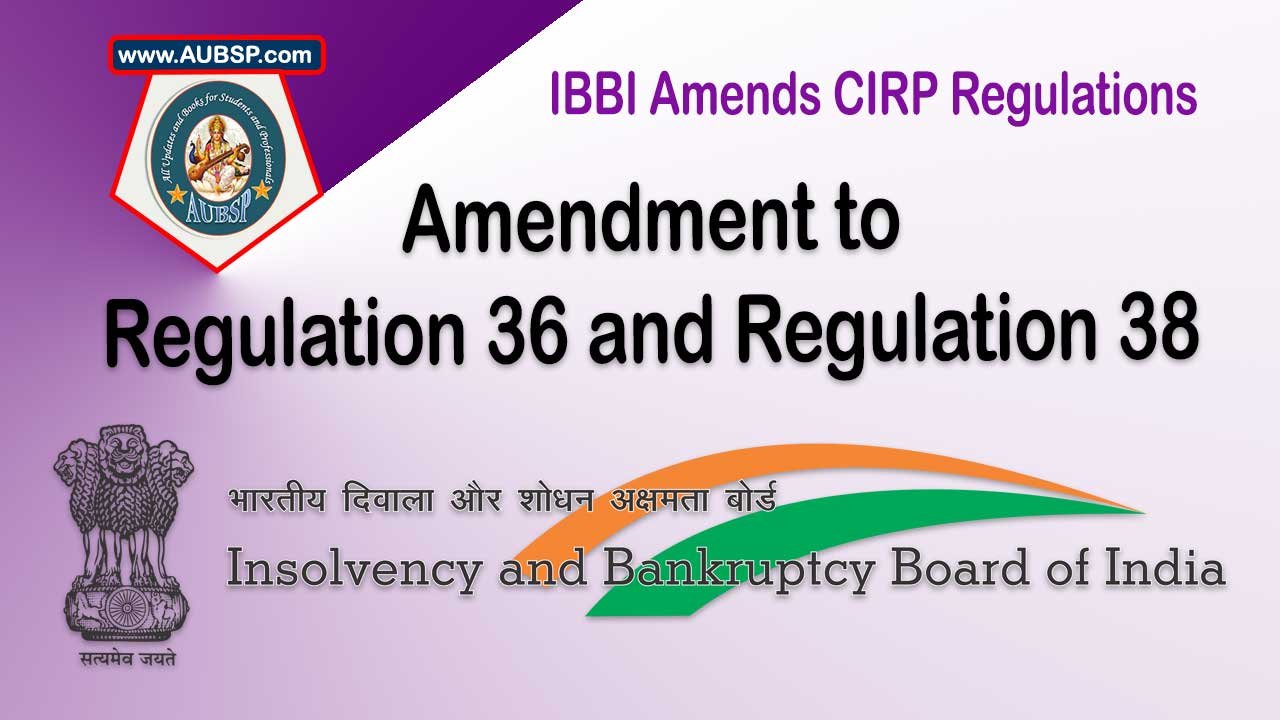On July 4, 2025, the Insolvency and Bankruptcy Board of India (IBBI) introduced the Fifth Amendment to the Insolvency Resolution Process for Corporate Persons Regulations, 2016, aimed at enhancing transparency and addressing avoidance transactions and fraudulent trading during the Corporate Insolvency Resolution Process (CIRP).
The amendment modifies Regulations 36 and 38 to mandate continuous updates to the information memorandum and require disclosure of identified avoidance transactions and fraudulent or wrongful trading. It also introduces a restriction preventing resolution plans from assigning such transactions unless they were disclosed and communicated to prospective applicants in advance.
The new provisions apply prospectively and exclude plans already submitted before the amendment’s commencement, ensuring a smoother transition in line with India’s evolving insolvency framework.
| Aspect | Details |
|---|---|
| Amendment Name | IBBI (Insolvency Resolution Process for Corporate Persons) (Fifth Amendment) Regulations, 2025 |
| Date of Notification | July 4, 2025 |
| Published In | The Gazette of India |
| Amended Regulations | Regulation 36 and Regulation 38 |
| Key Focus | Transparency, avoidance transactions, fraudulent/wrongful trading |
| Change in Regulation 36(1) | Requires continuous updates post insolvency commencement date |
| New Clause in 36(2) – (ha) | Mandatory disclosure of identified avoidance and fraudulent transactions |
| New Regulation 38(2A) | Prohibits assigning undisclosed avoidance transactions in resolution plans |
| Grace Clause | Not applicable to plans submitted before July 4, 2025 |
| Legal Basis | Section 196(1)(t) & Section 240 of IBC, 2016 |
IBBI Introduces Fifth Amendment to Corporate Insolvency Resolution Process Regulations
New Delhi, India – The Insolvency and Bankruptcy Board of India (IBBI) has announced the Insolvency and Bankruptcy Board of India (Insolvency Resolution Process for Corporate Persons) (Fifth Amendment) Regulations, 2025, which came into effect upon their publication in The Gazette of India on July 4, 2025. This significant amendment, published under F. No. IBBI/2025-26/GN/REG128 , introduces crucial changes to the existing Insolvency and Bankruptcy Board of India (Insolvency Resolution Process for Corporate Persons) Regulations, 2016.
The amendments aim to enhance transparency and address potential issues related to avoidance transactions and fraudulent trading during the corporate insolvency resolution process (CIRP).
Key Amendments to the Principal Regulations
The new regulations specifically modify Regulations 36 and 38 of the principal regulations.
- Changes to Regulation 36:
- Sub-regulation (1): The phrase “and its subsequent updates thereof,” has been inserted after the words “insolvency commencement date”. This change likely mandates that information related to the insolvency commencement date, possibly referring to the information memorandum, must be continuously updated.
- Sub-regulation (2): A new clause, (ha), has been added after clause (h). This new clause requires the inclusion of “details of all identified avoidance transactions, if any, under Chapter III or fraudulent or wrongful trading under Chapter VI of Part II of the Code and subsequent filings before Adjudicating Authority, as referred under sub-regulation (3A) of regulation 35A”. This emphasizes the disclosure of such transactions.
- Changes to Regulation 38:
- A new sub-regulation (2A) has been inserted after sub-regulation (2). This new sub-regulation places a critical restriction on resolution plans: “A resolution plan shall not provide for assignment of any avoidance transactions under Chapter III or fraudulent or wrongful trading under Chapter VI of Part II of the Code that were not: (a) disclosed in the information memorandum; and (b) intimated to all prospective resolution applicants under sub-regulation (3A) of regulation 35A before the last date for submission of resolution plans”.
- Proviso: Importantly, this sub-regulation (2A) “shall not apply to any resolution plan that has been submitted to the Adjudicating Authority under sub-section (6) of section 30 on or before the date of commencement of the Insolvency and Bankruptcy Board of India (Insolvency Resolution Process for Corporate Persons) (Fifth Amendment) Regulations, 2025”. This provides a grace period for resolution plans already submitted.
The amendments were enacted by the IBBI under the powers conferred by clause (t) of sub-section (1) of section 196 read with section 240 of the Insolvency and Bankruptcy Code, 2016 (31 of 2016). The notification was signed by Ravi Mital, Chairperson of the IBBI.
Background: The Insolvency and Bankruptcy Board of India (Insolvency Resolution Process for Corporate Persons) Regulations, 2016, were initially published on November 30, 2016. The last amendment to these regulations, the Insolvency and Bankruptcy Board of India (Insolvency Resolution Process for Corporate Persons) (Fourth Amendment) Regulations, 2025, was published on May 26, 2025. This latest, fifth amendment, continues the evolution of India’s insolvency framework.
FAQs on IBBI (Fifth Amendment) Regulations, 2025
What is the IBBI (Fifth Amendment) Regulations, 2025?
It refers to the fifth amendment to the Insolvency and Bankruptcy Board of India (Insolvency Resolution Process for Corporate Persons) Regulations, 2016, aimed at improving transparency and regulation of avoidance and fraudulent transactions during the corporate insolvency resolution process.
When was the Fifth Amendment notified?
The amendment was notified on July 4, 2025, and came into effect upon its publication in The Gazette of India.
What are the key objectives of the amendment?
The main goals are to enhance transparency, ensure proper disclosure of avoidance and fraudulent transactions, and restrict resolution plans from assigning such transactions unless they are properly disclosed.
Which regulations have been amended?
Regulations 36 and 38 of the IBBI (Insolvency Resolution Process for Corporate Persons) Regulations, 2016, have been amended.
What is the change in Regulation 36(1)?
The phrase “and its subsequent updates thereof” has been inserted after “insolvency commencement date”, requiring continuous updates of information, likely in the information memorandum.
What does the new clause (ha) in Regulation 36(2) specify?
It mandates inclusion of details on identified avoidance transactions and fraudulent or wrongful trading, along with any filings made before the Adjudicating Authority.
What is the new insertion in Regulation 38?
A new sub-regulation (2A) has been added, prohibiting resolution plans from assigning avoidance or fraudulent transactions unless they were disclosed in the information memorandum and shared with resolution applicants before the last date of submission.
Does the new sub-regulation (2A) apply retrospectively?
No, it does not apply to resolution plans submitted to the Adjudicating Authority on or before the commencement date of the Fifth Amendment (July 4, 2025).
What is the legal authority for enacting this amendment?
The amendment is enacted under Section 196(1)(t) and Section 240 of the Insolvency and Bankruptcy Code, 2016.
Who signed the notification for this amendment?
The notification was signed by Ravi Mital, Chairperson of the Insolvency and Bankruptcy Board of India (IBBI).
How does this amendment impact resolution professionals and applicants?
It places stricter disclosure obligations on resolution professionals and ensures resolution applicants receive complete and timely information on potential avoidance or fraudulent transactions.
Why is the disclosure of avoidance transactions important?
It ensures transparency in the resolution process, protects creditors’ interests, and prevents misuse of the insolvency framework for fraudulent gains.
What is an avoidance transaction under the IBC?
Avoidance transactions include preferential, undervalued, extortionate credit, and fraudulent transactions that may impact the fair resolution of a corporate debtor’s insolvency.
What is the significance of regulation 35A in relation to this amendment?
Regulation 35A outlines the procedure for identifying and reporting avoidance transactions, which must now be disclosed under the updated Regulations 36 and 38 as per the amendment.
How does this amendment benefit stakeholders?
It provides better access to critical transaction information, helps in fair decision-making, reduces litigation risk, and enhances confidence in the insolvency resolution process.
Does this amendment change the way resolution plans are evaluated?
Yes, resolution plans must now exclude assignment of undisclosed avoidance or fraudulent transactions, affecting how such plans are structured and approved.



Leave a Reply
You must be logged in to post a comment.